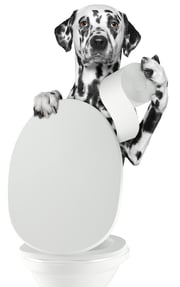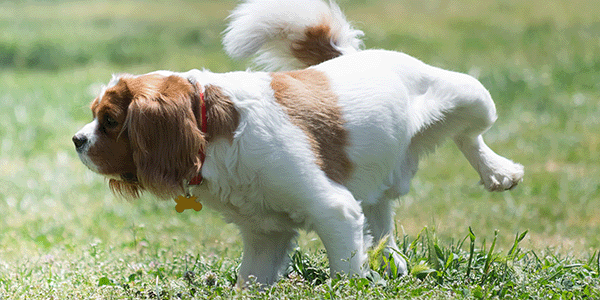- en
Pet InfoRx®
Dog Urinary Tract Infections & Bladder Stones
Your dog has a urinary tract infection or is suffering from bladder stones! Now what?
This pet information prescription will help you know what to do, how to make your dog more comfortable, and how to prevent this from happening in the future.
Quick Links
How Often Do Dogs Need to Pee?

How often a dog needs to go depends on their age, size, and if they have a medical condition, like a UTI. Most adult dogs need to pee 3–5 times a day. Puppies need to go every 1–2 hours, and dogs with urinary conditions could also need to go more frequently. They also sometimes have the urge to go, but nothing or not much comes out. That's definitely a sign of a urinary infection or blockage.
Our mission is to help save dogs' and cats’ lives through our educational content. To support our efforts, this page may contain affiliate links. We earn a commission for qualifying purchases – at no cost to you.
What Is a Urinary Tract Infection?
A urinary tract infection (UTI) is an infection, usually bacterial (but can be fungal or viral), in the urinary tract and can be quite uncomfortable for dogs.
Bacterial urinary tract infections are relatively common in dogs, affecting nearly 14% of dogs in their lifespan. And 4.5% of dogs will have recurring or persistent UTIs.
Most UTIs occur when bacteria gain access to the bladder by moving up the urethra and then attaching to the lining of the bladder. When a dog’s immune system is strong, and the body is properly functioning, the body can resist infection by removing the bacteria.
There is a list of several things under the "How Did This Happen" section below that can affect your dog’s immune system and body, increasing the chances of a UTI.
Signs of a urinary tract infection can include:
- bloody or cloudy urine
- straining and difficulty to urinate
- urinating inside (potty accidents)
- asking to go outside more frequently
- licking around their penis/vulva
- less energy and fever
Some dogs may show no signs of having a urinary tract infection.
How Did This Happen?
The most common cause of a simple UTI is bacterial growth in the bladder when your dog’s immune system is weakened. Bacteria develops when feces or other debris enters the area and then moves up the urethra into the bladder. Based on genetics and the pH level of the bladder, as well as your dog’s ability to absorb nutrients, some urinary tract environments are more prone to growing bacteria.
- Female dogs. They tend to get more UTIs than males due to their anatomy. Also, the fact that females can have a hooded vulva (excess tissue overlapping the vulva), which can trap moisture when they urinate.
Additionally, female dogs can have urinary incontinence, which can predispose them to a UTI. The urethral sphincter doesn’t stay closed, and bacteria can enter the bladder. - Male dogs. Male dogs that aren't neutered have a higher incidence of benign prostatic hyperplasia (enlargement of the prostate gland), which can cause prostatitis, a bacterial infection in the prostate, and, therefore, urinary tract infections. Benign prostatic hyperplasia in any male dog can cause urine retention, which can predispose them to a UTI.
- Fecal issues. Dogs suffering from fecal incontinence or chronic diarrhea have a higher rate of UTI if the area is not kept properly cleaned and trimmed.
- Spinal issues. Dogs that have suffered spinal injuries and cannot completely empty their bladder or need to be catheterized daily have higher rates of UTI. When the bladder does not fully empty, bacteria is left behind to grow. Catheters can introduce bacteria as well as cause irritation, which allows for the bacteria to take hold and grow.
- Steroids. Whilst they are often needed, steroids can lower your dog’s immune system and, therefore, possibly cause a UTI.
- Obesity. Extreme obesity has been linked to increased incidences of UTI.
- Disease. Dogs with diseases such as Cushing’s, diabetes, and kidney disease are at higher risk for acquiring UTIs.
- Breed Type. Certain breeds like Bichon Frise, Shih Tzu, and Yorkshire Terriers are more likely to get urinary tract stones and, therefore, UTIs. But really, any breed can be affected.
What You Should Do If Your Dog Has a UTI or Bladder Stones
If your veterinarian has diagnosed your dog with a UTI or bladder stones, you should follow their recommendations on prescription medications. Most dogs will be put on a broad-spectrum antibiotic to clear the bacterial infection. But depending on the type of bacteria, this antibiotic may need to be changed depending on the results of a follow-up urine culture.
The two most common types of crystals or stones that cause urinary issues are struvite and calcium oxalate. Your dog may have crystals, and no stones, stones, and no crystals or both can be present. Struvite crystals form when your dog's urine pH is high. These types of crystals can be dissolved as long as the urine stays acidic and is not too concentrated. This is one of many important reasons you need to be sure your dog drinks plenty of water. Having some struvite crystals can be normal in the urine. They become a concern when bacteria is present because then there is a risk of stone formation. Calcium oxalate crystals and stones form at a lower pH. Their formation appears to have a strong hereditary component. These cannot be dissolved. Stones in the bladder require surgery and need to be sent for stone analysis.
NOTE: In male dogs, due to the length and shape of their urethra, crystals and stones can cause a blockage. If this occurs, you must contact a veterinarian immediately.
Sometimes pain or anti-inflammatory medications will be provided to help with discomfort. Giving your dog probiotics may be recommended as well to help with bacteria in their stomach and intestines.
Your veterinarian may also recommend a prescription diet to change your dog's bladder's pH level in order to prevent recurring infections and bladder stone formation.
Keep Your Dog Comfortable
The best thing you can do is to administer medications and/or prescription diet as directed by your vet.
Make sure you are offering your dog water at all times – it is recommended to use distilled water and a water fountain, especially for dogs with a history of crystals or stones, because in some areas, well or city water has been found to have a high mineral content, which can lead to bladder stones. Your dog will also need more opportunities to go potty outside so they don't have accidents indoors.
For female dogs with a hooded vulva, you may need to clean and care for the area as directed by your veterinarian.
How Do You Know Things Are Improving?
You should notice a decrease in your dog’s discomfort, straining when urinating, and licking their private areas.
The urine should also start to look more clear and yellow in color. A recheck exam and urine testing are recommended to make sure your dog has cleared their infection. Your veterinarian may also request a follow-up culture about 4 weeks after you have finished all the medications prescribed. This helps ensure that there are no reoccurrences.

How Do You Know When Things Are Not Improving? What You Should Do.
If at any point your dog is straining to urinate and not producing urine or the urine appears bloody, this can be an emergency, and your pet should be taken to the vet right away. This could mean that your dog has crystals or stones blocking their urethra. It can then cause urine to overfill the bladder, causing it to rupture. It may also indicate that the kidneys are not functioning properly.
If your pet has not shown any improvements on the medications after 1 week, you should schedule a recheck with your veterinarian. At this time, your vet will likely recommend x-rays to check for a bladder stone or mass, ultrasound, and possibly bloodwork to check for another contributing disease. Keep your vet updated on your pet’s progress.

How to Prevent This from Happening in the Future
Some dogs can have recurring UTIs. To prevent a recurrence, make sure you finish all medications prescribed by your veterinarian, even if your dog seems fine. Follow all recommendations for follow-up testing (urine cultures) as well.
If your dog was prescribed a specific diet, make sure they eat this food and this food only. This often means no additional snacks or treats. Make sure your dog always has access to fresh, clean water and that they are allowed access to go outside multiple times per day.
If your pet is overweight or obese, work with your veterinarian to develop a diet and exercise regime to help properly decrease their weight. Losing weight is not only good to prevent urinary tract infections, but a whole host of other concerning diseases.
If your female dog has a hooded vulva, your veterinarian may recommend surgery to correct it to help prevent recurring UTI. Be sure to regularly and gently clean the area after urination if surgery is not recommended. Some dogs have also had improvement with this condition when they lose weight.
For some intact male dogs, it may become necessary to neuter them to help shrink the prostate in order that they can urinate easier and lessen the incidence of prostatitis.

The Pet InfoRx® is made possible, in part, through our partnership with AlignCare®.


© Preventive Vet. All rights reserved. PreventiveVet.com

